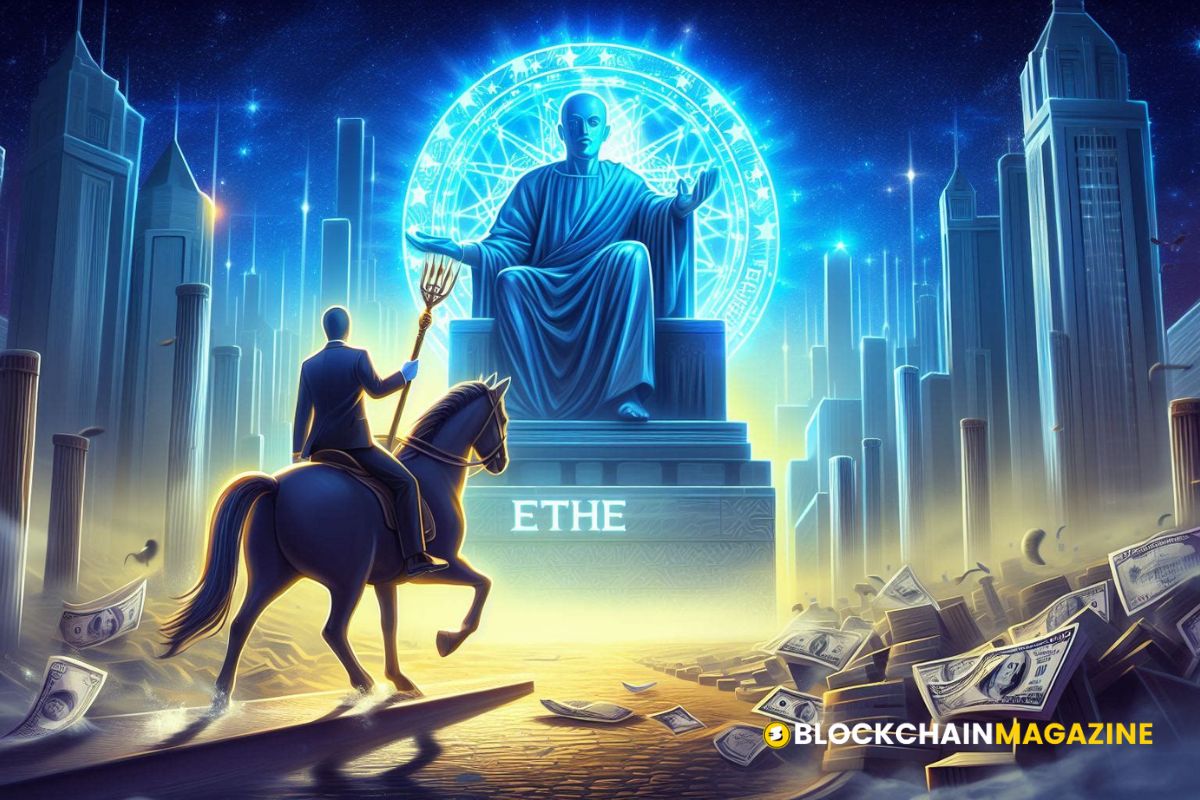Capitalizing on the Ether Merge with Futures and Options: A Speculative Trading Approach in 2024
In the dynamic world of cryptocurrency trading, the Ether Merge has emerged as a pivotal event with far-reaching implications for traders and investors. With the U.S. Securities and Exchange Commission approving spot markets for ether in May 2024, traders now have regulated avenues to speculate on ether’s prices without directly purchasing the crypto tokens. This article delves into the intricacies of the Ether Merge and explores how futures and options can be leveraged for speculative trading in 2024.
Key Takeaways
- The Ether Merge represents a significant milestone for the Ethereum network, impacting its scalability and efficiency.
- Traders can now speculate on ether prices through regulated futures ETFs, offering an alternative to direct crypto token purchases.
- Understanding the differences between ether futures and options is crucial for effective trading strategies.
- Platforms like ProShares Ether Strategy ETF, Kraken, and Binance provide various tools and opportunities for trading ether futures.
- Risk management techniques and awareness of market conditions, such as contango and backwardation, are essential for successful trading.
Understanding the Ether Merge and Its Impact on Trading
What is the Ether Merge?
The Ether Merge refers to Ethereum’s transition from a Proof-of-Work (PoW) to a Proof-of-Stake (PoS) consensus mechanism. This shift is designed to enhance the network’s scalability, security, and energy efficiency. The successful transition of Ethereum to a PoS system has been a key milestone for widening the network’s reach.
Implications for the Ethereum Network
The move to PoS significantly reduces the energy consumption of the Ethereum network, making it more sustainable. Additionally, it introduces staking, where participants can earn rewards by locking up their ether. This change is expected to attract more institutional investors and developers to the platform.
Market Reactions to the Ether Merge
Ether’s price has been highly volatile, but it grew tremendously amid the increased adoption of DeFi and NFTs. The successful transition has led to increased confidence among investors, driving up the price. Spot markets for ether, which trade the underlying assets, were effectively approved by the U.S. Securities and Exchange Commission in May 2024, further boosting market sentiment.
The Ether Merge represents a pivotal moment for Ethereum, potentially transforming it into a more robust and eco-friendly blockchain network.
Navigating Ether Futures and Options
Basics of Ether Futures
Ether futures are financial contracts obligating the buyer to purchase Ether at a predetermined future date and price. These contracts are standardized and traded on exchanges, providing a way to speculate on the future price of Ether without owning the actual cryptocurrency. Traders can take advantage of price movements by going long or short on these contracts.
Introduction to Ether Options
Ether options give traders the right, but not the obligation, to buy or sell Ether at a specified price before a certain date. This flexibility allows for various trading strategies, including hedging against price volatility. Options can be categorized into calls and puts, each serving different purposes in a trading strategy.
Key Differences Between Futures and Options
While both futures and options are derivatives, they have distinct characteristics:
- Obligation vs. Right: Futures contracts obligate the parties to transact, whereas options provide the right without obligation.
- Risk and Reward: Futures carry higher risk due to the obligation to fulfill the contract, while options limit the risk to the premium paid.
- Flexibility: Options offer more flexibility in trading strategies compared to futures.
Understanding these differences is crucial for traders looking to capitalize on the Ether Merge with futures and options.
Top Platforms for Trading Ether Futures
The ProShares Ether Strategy ETF is a popular choice for those looking to gain exposure to Ethereum price movements without directly owning the cryptocurrency. This ETF offers a convenient way to invest in Ether futures through a traditional brokerage account. It is important to understand the bid-ask spreads to evaluate trading costs and keep informed about contract expiration dates and conditions.
Kraken and Binance are two of the most well-known cryptocurrency exchanges that offer Ether futures trading. These platforms provide high liquidity, facilitating quick entry and exit. Kraken is known for its user-friendly experience and performant API trading, while Binance offers a wide range of contract specifications and margin requirements. Monitoring the funding rate is crucial if trading perpetual futures contracts.
Various leverage trading exchanges allow traders to amplify their returns by using leverage. However, this also increases risk. It is essential to assess settlement terms—either physical delivery of ETH or cash settlement. Leverage can be a double-edged sword, offering the potential for higher returns but also increasing the risk of significant losses.
When trading Ether futures, always consider the liquidity, exposure, hedging opportunities, and leverage options available on the platform you choose.
Strategies for Speculating on Ether Prices
Long and Short Positions
Taking long and short positions in Ether can be a profitable strategy for traders who can accurately predict market movements. Long positions involve buying Ether with the expectation that its price will rise, while short positions involve selling Ether with the expectation that its price will fall. Spot markets for ether, which trade the underlying assets, were effectively approved by the U.S. Securities and Exchange Commission in May 2024, providing traders with more avenues to speculate on ether’s prices without buying the crypto tokens directly.
Using Leverage in Ether Trading
Leverage allows traders to control a larger position with a smaller amount of capital. This can amplify both gains and losses, making it a double-edged sword. For instance, a 10x leverage means that a 1% increase in Ether’s price could result in a 10% gain on the trader’s position. However, it also means that a 1% decrease could result in a 10% loss. Therefore, using leverage requires a well-thought-out strategy and a high risk tolerance.
Risk Management Techniques
Effective risk management is crucial when trading Ether futures and options. Some common techniques include:
- Setting stop-loss orders to limit potential losses.
- Diversifying investments to spread risk.
- Regularly reviewing and adjusting trading strategies based on market conditions.
Investing in an ether futures ETF, as with any investment, requires meticulous research and a well-thought-out strategy. You should understand not only the mechanics of Ethereum and its performance on the market but also the management, fees, and performance of the ETF you are looking at. Moreover, consulting with a financial advisor well versed in cryptocurrencies and traditional finance is strongly advised.
Evaluating the Risks and Rewards of Ether Futures ETFs
Understanding Contango and Backwardation
Contango and backwardation are critical concepts in futures trading. Contango occurs when the futures price of an asset is higher than the spot price, often due to storage costs or expectations of rising prices. Conversely, backwardation happens when the futures price is lower than the spot price, usually due to high demand or anticipated price drops. These conditions can significantly impact the performance of Ether futures ETFs, making it essential for investors to understand these dynamics.
Assessing Management Fees and Performance
Investing in an Ether futures ETF requires careful consideration of management fees and overall performance. High fees can erode returns, especially in a volatile market. It’s crucial to compare different ETFs and their fee structures. Here’s a quick comparison:
| ETF Name | Management Fee | Performance (YTD) |
|---|---|---|
| ETF A | 0.75% | 12% |
| ETF B | 0.50% | 10% |
| ETF C | 1.00% | 15% |
Potential Benefits of Investing in Ether Futures ETFs
Ether futures ETFs offer several benefits, including accessibility and diversification. By providing exposure to Ether within a regulated fund structure, these ETFs allow a wider range of investors to participate in the cryptocurrency market. However, it’s important to note that the crypto market itself is not regulated, which adds a layer of risk.
Investing in an Ether futures ETF, as with any investment, requires meticulous research and a well-thought-out strategy. Consulting with a financial advisor well-versed in cryptocurrencies and traditional finance is strongly advised.
However, there are inherent risks, from volatility to regulatory uncertainty. While providing access to a novel asset class, Ether futures ETFs are complex instruments unsuitable for casual investors.
Regulatory Landscape for Ether Futures and Options
SEC Approval and Its Implications
The approval of Ether futures ETFs by the U.S. Securities and Exchange Commission (SEC) has been a significant milestone. Market optimism increased with the approval odds for Ether ETFs, especially after BlackRock, Grayscale, and Bitwise amended spot Ether ETF proposals to address regulatory hurdles. This approval has opened up new avenues for investors to speculate on Ether prices without directly owning the cryptocurrency.
Compliance Requirements for Traders
Traders engaging in Ether futures and options must adhere to stringent compliance requirements. These include maintaining proper records, adhering to anti-money laundering (AML) regulations, and ensuring that all trading activities are transparent and traceable. Failure to comply can result in severe penalties, including fines and trading bans.
Future Regulatory Developments
The regulatory landscape for Ether futures and options is continually evolving. Future developments may include more comprehensive guidelines on trading practices, enhanced scrutiny of trading platforms, and possibly the introduction of new regulatory bodies to oversee the market. Traders should stay informed about these changes to navigate the market effectively.
The evolving regulatory environment necessitates that traders remain vigilant and adaptable to ensure compliance and capitalize on new opportunities.
Case Studies: Success and Failure in Ether Futures Trading
Successful Trading Strategies
One of the most successful trading strategies in Ether futures has been the use of algorithmic trading. Traders have leveraged automated systems to capitalize on minute price movements, ensuring consistent profits. Another effective approach has been the strategic use of leverage, allowing traders to amplify their gains significantly.
Common Pitfalls and How to Avoid Them
A frequent pitfall in Ether futures trading is the failure to understand the implications of contract expiration dates. Traders often overlook the need to roll over contracts, leading to unexpected losses. Additionally, many traders underestimate the impact of market volatility, which can result in substantial financial setbacks.
Lessons from Notable Traders
Notable traders have emphasized the importance of risk management techniques. For instance, setting stop-loss orders has been a crucial practice to mitigate potential losses. Moreover, staying informed about the regulatory landscape, such as the intriguing Ethereum ETF approval by SEC, could spark investor influx and impact Ether prices in 2024. Market reactions, regulatory landscape, and potential performance differences highlighted.
Understanding the market dynamics and staying updated with regulatory changes are key to successful Ether futures trading.
In our latest section, “Case Studies: Success and Failure in Ether Futures Trading,” we delve into real-world examples that highlight the highs and lows of trading Ether futures. Whether you’re a seasoned trader or just starting out, these case studies offer invaluable insights. Don’t miss out on the latest trends and expert analysis—visit our website today!
Conclusion
The Ether Merge has opened up new speculative trading opportunities through futures and options, particularly with the introduction of regulated Ether futures ETFs. These instruments provide a way for investors to gain exposure to Ethereum’s price movements without directly holding the cryptocurrency. While the contango effect and other market dynamics present challenges, skilled fund managers and informed trading strategies can help mitigate some of these risks. As the market for Ether futures ETFs continues to evolve, it offers both traditional and crypto-savvy investors a unique avenue to capitalize on Ethereum’s potential. However, thorough research and consultation with financial advisors are essential to navigate this complex landscape effectively.
Frequently Asked Questions
What is the Ether Merge?
The Ether Merge refers to Ethereum’s transition from a Proof-of-Work (PoW) consensus mechanism to a Proof-of-Stake (PoS) system. This change aims to improve scalability, security, and energy efficiency.
How does the Ether Merge impact trading?
The Ether Merge can affect trading by altering market dynamics, potentially increasing volatility. Traders may need to adjust their strategies to account for changes in transaction speeds, fees, and overall network security.
What are Ether Futures?
Ether Futures are financial contracts that obligate the buyer to purchase, and the seller to sell, Ether at a predetermined future date and price. They are used for hedging or speculative purposes.
How do Ether Options differ from Ether Futures?
Ether Options give traders the right, but not the obligation, to buy or sell Ether at a specified price before a certain date. In contrast, Ether Futures obligate traders to complete the transaction at the set date and price.
What platforms are best for trading Ether Futures?
Top platforms for trading Ether Futures include ProShares Ether Strategy ETF, Kraken, Binance, and various leverage trading exchanges.
What are the risks of investing in Ether Futures ETFs?
Investing in Ether Futures ETFs carries risks such as market volatility, contango effects, and management fees. It is crucial to conduct thorough research and consider consulting a financial advisor.
Stay informed with daily updates from Blockchain Magazine on Google News. Click here to follow us and mark as favorite: [Blockchain Magazine on Google News].
Get Blockchain Insights In Inbox
Stay ahead of the curve with expert analysis and market updates.
latest from tech
Disclaimer: Any post shared by a third-party agency are sponsored and Blockchain Magazine has no views on any such posts. The views and opinions expressed in this post are those of the clients and do not necessarily reflect the official policy or position of Blockchain Magazine. The information provided in this post is for informational purposes only and should not be considered as financial, investment, or professional advice. Blockchain Magazine does not endorse or promote any specific products, services, or companies mentioned in this posts. Readers are encouraged to conduct their own research and consult with a qualified professional before making any financial decisions. The featured image used is just a creative depiction of the title and it does not intend to hurt sentiments of any person or institution. If it hurts anyone sentiments, please do not hesitate to reach out to Blockchain Magazine.

 Bitcoin
Bitcoin  Ethereum
Ethereum  XRP
XRP  Tether
Tether  Solana
Solana  Dogecoin
Dogecoin  USDC
USDC  Cardano
Cardano  Lido Staked Ether
Lido Staked Ether  TRON
TRON  Chainlink
Chainlink  Avalanche
Avalanche  Wrapped stETH
Wrapped stETH  Sui
Sui  Wrapped Bitcoin
Wrapped Bitcoin  Toncoin
Toncoin  Stellar
Stellar  Hedera
Hedera  Shiba Inu
Shiba Inu  Polkadot
Polkadot  WETH
WETH  LEO Token
LEO Token  Litecoin
Litecoin  Bitcoin Cash
Bitcoin Cash  Bitget Token
Bitget Token  Hyperliquid
Hyperliquid  Uniswap
Uniswap  Official Trump
Official Trump  USDS
USDS  Wrapped eETH
Wrapped eETH  Pepe
Pepe  NEAR Protocol
NEAR Protocol  Ethena USDe
Ethena USDe  Aave
Aave  Aptos
Aptos  Internet Computer
Internet Computer  Monero
Monero  WhiteBIT Coin
WhiteBIT Coin  Ondo
Ondo  Ethereum Classic
Ethereum Classic  Cronos
Cronos  POL (ex-MATIC)
POL (ex-MATIC)  Mantle
Mantle  Render
Render  Dai
Dai  MANTRA
MANTRA  Algorand
Algorand 




